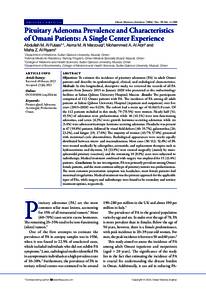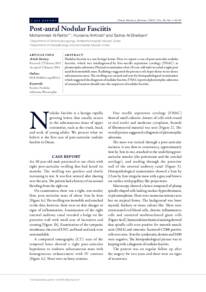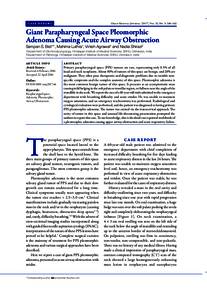Document
Pituitary adenoma prevalence and characteristics of Omani patients : A single center experience.
Identifier
DOI 10.5001/omj.2024.44
Source
Oman Medical Journal, v. 39, no. 1, e589 p. [1-5].
Contributors
Country
Oman
City
Muscat
Publisher
Oman Medical Specialty Board.
Gregorian
2024-01-01
Language
English
English abstract
To estimate the incidence of pituitary adenomas (PA) in adult Omani
patients and describe its epidemiological, clinical, and radiological characteristics.
Methods: In this longitudinal, descriptive study, we reviewed the records of all PA
patients from January 2015 to January 2020 who presented at the endocrinology
facilities at Sultan Qaboos University Hospital, Muscat. Results: The participants
comprised of 112 Omani patients with PA. The incidence of PA among all adult
patients at Sultan Qaboos University Hospital (inpatient and outpatient) over five
years (2015–2020) was 0.23%. The cohort had a mean age of 41.0±15.0 years. Of
the 112 patients included in this study, 79 (70.5%) were women. Nearly half (51;
45.5%) of adenomas were prolactinomas while 46 (41.1%) were non-functioning
adenomas, and seven (6.3%) were growth hormone-secreting adenomas while six
(5.4%) were adrenocorticotropic hormone secreting adenomas. Headache was present
in 67 (59.8%) patients, followed by visual field defects (40; 35.7%), galactorrhea (26;
23.2%), and fatigue (19; 17.0%). The majority of women (45/79; 57.0%) presented
with menstrual cycle abnormalities. Radiological appearances were nearly equally
distributed between micro- and macroadenomas. Most cases (58/112; 52.0%) of PA
were treated medically by cabergoline, octreotide, and replacement therapies such as
hydrocortisone and thyroxin, 38 (33.9%) were treated surgically (mainly by transsphenoidal pituitary resection), and the remaining 10 (8.9%) cases were subjected to
radiotherapy. Medical treatment combined with surgery was employed for 15 (13.4%)
patients. Conclusions: In our investigation, PA was primarily prevalent among Omani
female patients, and the most common subtype of pituitary tumors was prolactinomas.
The most common presentation symptom was headaches; most female patients had
menstrual irregularities. Medical treatment was the primary approach for the applicable
types of PAs, while surgery and radiotherapy were found to be secondary and tertiary
treatment options, respectively.
ISSN
1999-768X (Print)
2070-5204 (Electronic)
Category
Journal articles



